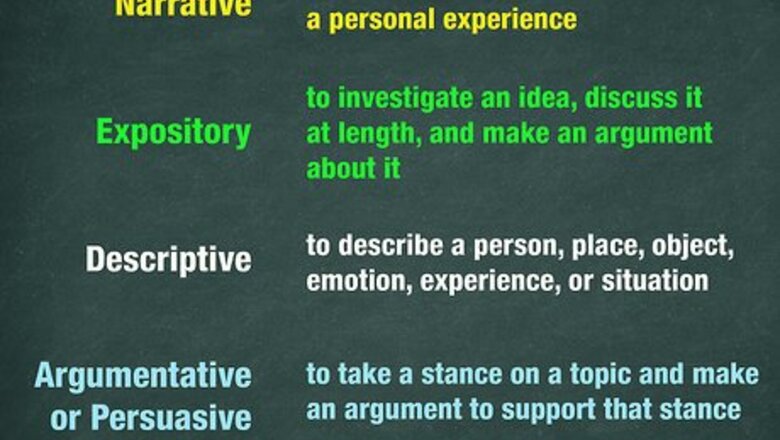
views
Choosing Genres and Topics

Choose an essay genre to assign to your students. An essay is a form of writing, but there are many different essay genres. Decide what type of essay you want your students to write and explain the genre to them. Be sure to include details about each genre's key features. Some commonly assigned essay genres include: Narrative, which is a non-fiction account of a personal experience. This is a good option if you want your students to share a story about something they did, such as a challenge they overcame or a favorite vacation they took. Expository, which is when you investigate an idea, discuss it at length, and make an argument about it. This might be a good option if you want students to explore a specific concept or a controversial subject. Descriptive, which is when you describe a person, place, object, emotion, experience, or situation. This can be a good way to allow your students to express themselves creatively through writing. Argumentative or persuasive essays require students to take a stance on a topic and make an argument to support that stance. This is different from an expository essay in that students won't be discussing a concept at length and then taking a position. The goal of an argumentative essay is to take a position right away and defend it with evidence.

Provide models of the type of essay you want your students to write. Once you have identified the type of essay you want your students to write, choose essays that were written in that genre to use as models. You can collect individual essays and assign 1 at a time, or use a reader and have students read essays in the genre you have selected. Make sure to select essays that are well-structured and interesting so that your students can model their own essays after these examples. Include essays written by former students, if you can, as well as professionally written essays.Tip: Readers come in many forms. You can find readers that focus on a specific topic, such as food or pop culture. You can also find reader/handbook combos that will provide general information on writing along with the model essays.

Divide students into small groups to discuss model essays. Having your students work together to examine model essays in class will help them to gain a better understanding of what makes a good essay. Give your students questions and have them work together to answer them. For example, for each of the essays you assign your students, you could ask them to identify the author's main point or focus, the structure of the essay, the author's use of sources, and the effect of the introduction and conclusion. Ask the students to create a reverse outline of the essay to help them understand how to construct a well-written essay. They'll identify the thesis, the main points of the body paragraphs, the supporting evidence, and the concluding statement. Then, they'll present this information in an outline.

Encourage students to choose a topic that matters to them. Writing is more engaging if you choose a topic that interests you, so encourage your students to do this. If possible, allow them to choose their topics so that they will be able to choose something they care about and that interests them. For example, if you have assigned your students a narrative essay, then encourage them to choose a story that they love to tell or a story they have always wanted to tell but never have. If your students are writing argumentative essays, encourage them to select a topic that they feel strongly about or that they'd like to learn more about so that they can voice their opinion.
Explaining the Parts of an Essay
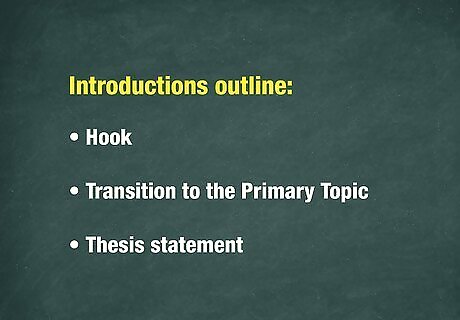
Provide examples of effective introductions. Starting an essay can be one of the most difficult parts of writing an essay. Your students may be tempted to begin with a broad, sweeping introduction, or they start out with something that sounds generic or bland, such as a cliché saying or quote. Make sure to point to good introduction examples from the model essays you assign so that students will know what you're looking for. For example, if you read an essay that begins with an interesting anecdote, highlight that in your class discussion of the essay. Ask students how they could integrate something like that into their own essays and have them write an anecdotal intro in class. Or, if you read an essay that starts with a shocking fact or statistic that grabs readers' attention, point this out to your students. Ask them to identify the most shocking fact or statistic related to their essay topic.

Explain how to write a strong thesis. A thesis statement is the central claim of an essay and it usually appears at the end of the introduction. Make sure to identify the thesis in each of the essays you read with your students so that they will have plenty of models to refer to. Also, make sure to spend time in class going over how to write a thesis statement. For example, you could provide a few model thesis statements that students can use as templates and then ask them to write a thesis for their topic as an in-class activity or have them post it on an online discussion board.Tip: Even though the thesis statement is only 1 sentence, this can be the most challenging part of writing an essay for some students. Plan to spend a full class session on writing thesis statements and review the information multiple times as well.
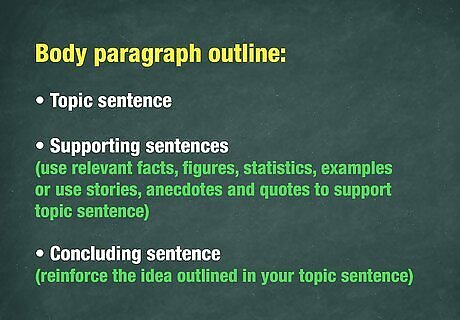
Show students how to introduce and support their claims. Each of the body paragraphs in an expository or argumentative essay should include a claim that is supported by research. This may include things like statistics, results of a study, or quotes by experts. Show your students how to structure their body paragraphs with this information. For example, you could spend a class session going over topic sentences, and then look at how the authors of model essays have used topic sentences to introduce their claims. Then, identify where the author provides support for a claim and how they expand on the source.
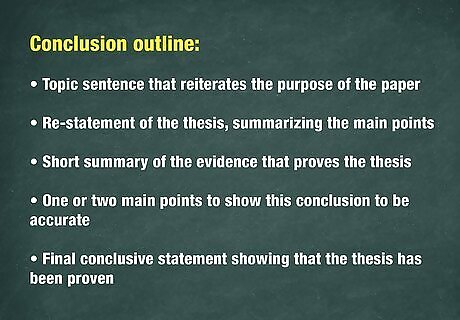
Give students examples of how to conclude an essay. Students sometimes get in a rush to be done with an essay once they have covered all of their main points, so it is common for conclusions to seem abrupt or awkward. Help students understand the goal of the conclusion by referring to conclusions in the model essays you read with them. For example, you might direct students to a conclusion in a narrative essay that reflects on the significance of an author's experience. Ask students to write a paragraph where they reflect on the experience they are writing about and turn it in as homework or share it on class discussion board. For an expository or argumentative essay, you might show students conclusions that restate the most important aspect of a topic or that offer solutions for the future. Have students write their own conclusions that restate the most important parts of their subject or that outline some possible solutions to the problem.
Guiding Students Through the Writing Process
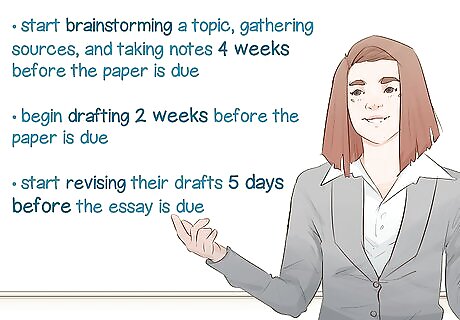
Explain the writing process so students will know to start early. Writing is something that many students don't see as a long, complex process. They might think it's fine to sit down and write an essay the night before it's due, but this usually results in poor writing. Explain to your students that writing a good essay requires deep thought, careful planning, and multiple revisions. Try giving students a sample timeline for how to work on their essays. For example, they might start brainstorming a topic, gathering sources (if required), and taking notes 4 weeks before the paper is due. Then, students might begin drafting 2 weeks before the paper is due with a goal of having a full draft 1 week before the essay's due date. Students could then plan to start revising their drafts 5 days before the essay is due. This will provide students with ample time to read through their papers a few times and make changes as needed.
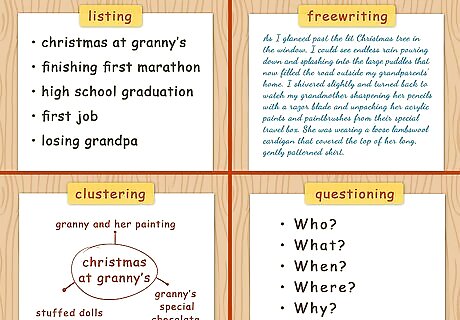
Discuss the importance of brainstorming to generate ideas. Explain to students what brainstorming is and how it can help them to write a better essay. Provide them with a list of different types of brainstorming activities and set aside class time to try some of them out. Some brainstorming activities you could encourage your students to try include: Freewriting, which is when you write freely about anything that comes to mind for a set amount of time, such as 10, 15, or 20 minutes. Clustering, which is when you write your topic or topic idea on a piece of paper and then use lines to connect that idea to others. Listing, which is when you make a list of any and all ideas related to a topic and ten read through it to find helpful information for your paper. Questioning, such as by answering the who, what, when, where, why, and how of their topic. Defining terms, such as identifying all of the key terms related to their topic and writing out definitions for each one.
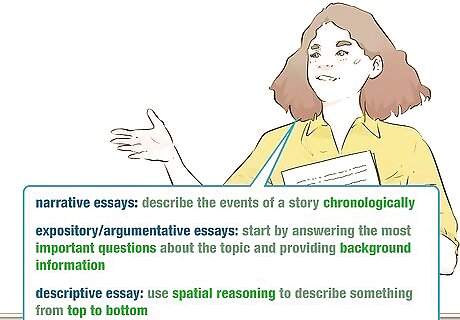
Instruct students on different ways to organize their thoughts. Once students have developed some preliminary ideas for their essay, they may be wondering how to organize everything in a way that makes sense. Show students different approaches to organizing an essay depending on their topic and the essay's genre. For example, if your students are writing narrative essays, then it might make the most sense for them to describe the events of a story chronologically. If students are writing expository or argumentative essays, then they might need to start by answering the most important questions about their topic and providing background information. For a descriptive essay, students might use spatial reasoning to describe something from top to bottom, or organize the descriptive paragraphs into categories for each of the 5 senses, such as sight, sound, smell, taste, and feel.

Use in-class writing exercises to help students develop ideas. You will often need to explain concepts to students, and this may involve you talking and writing on the board or using a PowerPoint for a portion of the class. However, it is also important to get students talking and thinking about the concepts you are trying to teach them. Try starting or ending each class with a writing exercise to get students engaged with a new concept or idea. For example, if you have just gone over different types of brainstorming strategies, you might ask students to choose 1 that they like and spend 10 minutes developing ideas for their essay.
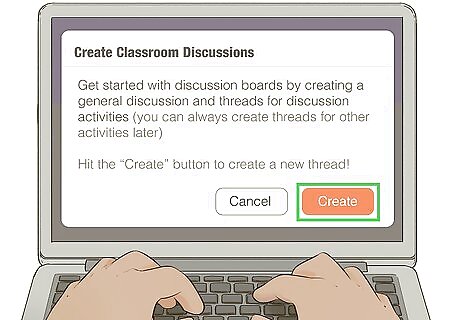
Create a discussion board and require students to post regularly. Using an online discussion board is a popular way to keep students engaged with the course material. They can access the board any time of the day or night and read what other students have written. This will also create a more laid back environment for students to complete writing activities than if you were to do timed activities in your classroom. Try having students post a weekly response to a writing prompt or question that you assign. You may also want to create a separate discussion board where students can post ideas about their essay and get feedback from you and their classmates.

Give students homework to help them develop their essays. Be thoughtful with the types of homework you assign so that it will be useful for your students as they work on their essays. For example, you could assign students to write 1 paragraph of ideas for their paper as a first assignment. Then, they could choose a focus for the next homework assignment and expand on those ideas in a new paragraph. You could also assign specific parts of the writing process as homework, such as requiring students to hand in a first draft as a homework assignment.
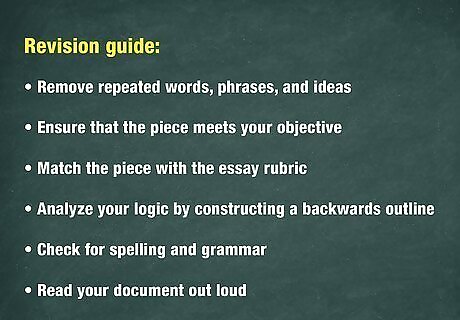
Schedule in-class revision sessions. Revision is an essential part of the writing process, but your students may not see it that way. To ensure that your students will revise their work, make revision part of the class. Explain different types of revision techniques to your students and then provide them with class time to revise their work. Provide students with a list of questions and strategies that they can use and allow them to choose what they find most helpful. For example, you might suggest reading the paper backward 1 sentence at a time or reading the paper out loud as a way to identify issues with organization and to weed out minor errors. Try peer-review workshops that ask students to review each others' work. Students can work in pairs or groups during the workshop. Provide them with a worksheet, graphic organizer, or copy of the assignment rubric to guide their peer-review.Tip: Emphasize the importance of giving yourself at least a few hours away from the essay before you revise it. If possible, it is even better to wait a few days. After this time passes, it is often easier to spot errors and work out better ways of describing things.




















Comments
0 comment